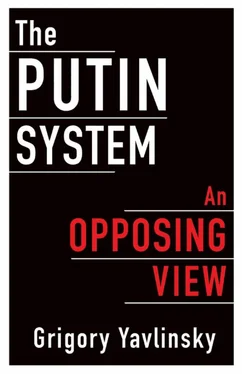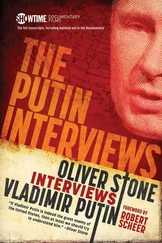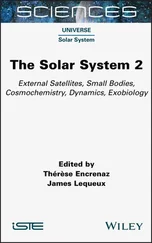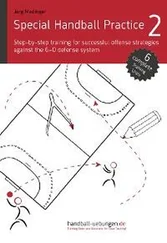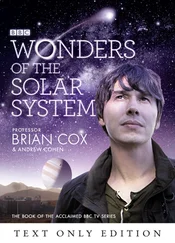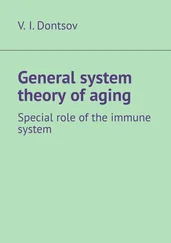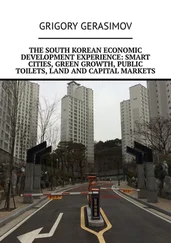At the same time, the authorities embarked upon a more active pursuit of an additional source of support, in the realm of ideology. Eventually, they discovered it in the conservative valorization of the status quo, which included a quasi-religious veneration of the powers that be; the notion of a “peoplehood,” understood as an inseparable bond between the people and its government; and an emphasis upon “traditional values.” This ideological mix also included a cult of the princely symbols of national “grandeur,” coupled with overconfidence regarding the potency of the widely touted symbiotic relationship between the authorities and the people, as well as xenophobia, with its perception of a hostile international encirclement and a country besieged by its enemies and their minions. By about 2010, all the ingredients of this mix became fairly pronounced and firmly implanted in the style and political content of government-owned and government-oriented media and in the official statements and pronouncements by members of the ruling circle and pro-government cultural figures.
Finally, I have noted that the increasing ideological zeal of Russia’s authorities, and their attempts to find an additional source of support through a more aggressive brainwashing of the public, has had two implications. On the one hand, it attests to the fact that the system has already passed the peak of its resilience. It is in the process of losing, or has already lost, its prior confidence that the relatively comfortable, safe strategy of nonideological control over the situation in the country is sufficient for its purposes. On the other hand, such actions by the authorities are extremely risky, as they awaken and energize forces within society that are capable of causing havoc and that will be quite difficult to keep under control.
Under these circumstances, a natural and rather tempting solution to this quandary is to remake the state in an ideological mold. In such an ideologically defined state, defending, promoting, and asserting the ideology that suits the authorities becomes an item on the government’s agenda. Meanwhile, all opinions that are not officially sanctioned are excluded from the range of the acceptable and are effectively suppressed. In other words, the authorities set themselves upon the slippery slope of a transformation of their authoritarian system into a totalitarian one, with all the implications of this change.
These are precisely the trends that, in recent years, have been increasingly infiltrating Russia’s political life and, moreover, that have started to turn into a permanent fixture. All the main features of the Kremlin’s “new” set of policies have become full-fledged components of the official ideology—even though all the ingredients of its eclectic mix were simply borrowed from various periods of Russia’s history, from early medieval autocracy to the Soviet era. [5]They have replaced the residual rhetoric of “transition,” with its ritualistic vows of loyalty to the principles of democracy, human rights, and economic freedom. The course toward political isolation from “Western” influence has made these incantations not just unnecessary but even detrimental in terms of mobilizing popular support for the new ideological direction. This is why all the “programmatic” statements and documents that have emanated from the top of the hierarchy of power since about 2015 have already been virtually devoid of any trace of the liberal frame of mind. Instead, they are single-mindedly focused on the notion of a unified and monolithic power, its direct reliance upon the “will of the people” (without any mention of the tools of representative democracy), and the building of relations with the outside world entirely on the Kremlin’s own terms and from a position of power.
A huge part of this new ideological framework is the premise that it is the authorities’ duty to protect and invigorate traditional values, safeguarding them from potential “corrosion” or dilution by external influences. The propaganda firmly binds these traditional values to Russian ethnicity and Russia’s landmass and, further, envisions them as a given (as “primordial foundations”) that is not subject to change, rethinking, or even adjustment based on new realities. Essentially, this new ideological construct no longer envisions government as a product of some social bargain but rather views it as the direct expression of the popular or national spirit, the “spirit of the turf,” whose raison d’être is to organize Russian resistance to the a priori hostile and alien outside world.
Such a model of government organization and functioning leaves no room for any separation or distribution of power among competing agencies, nor for any mechanism of holding this supreme authority accountable for its actions. At most, what can fit into this construction is a modicum of control, however ineffective, over the activities of the lowest levels of the government machinery, exercised by the population “from below.” That is, the authorities may consider cooperating with citizens in holding junior government staff to account, but nothing more.
It is natural that the shift in ideological emphasis necessitated adjustments in the editorial policies of the national TV channels, which have served as the primary tool in the authorities’ engagement with public opinion. These channels now began deleting references to the existence of viewpoints different from the official policy, even if those references were critical of these alternate views. And when these viewpoints do get mentioned, they are invariably accompanied by comments about the existence of a “fifth column” in the country, which works to advance foreign interests. Those who represent other ideologies have been reclassified from intellectual schismatics to committed enemies of Russia’s national statehood who must be denied even the tiniest place in public and political life. Meanwhile, the intensity of propaganda has been maximized and is now bordering on hysteria. The authorities have been purging all the institutions that have any access to public opinion—from the State Duma to the Chamber of Nongovernmental Representatives under the presidential administration—of “troublemakers” who have used their membership in these agencies to convey their antigovernment opinions to the public.
Simultaneously, the Kremlin upgraded the role of the dominant ideology as the theoretical justification for political and everyday xenophobia as well as for the exceptional importance of state-oriented consciousness among Russians. Prior to that, the notion of the “Russian world”—the worldwide community of Russians, mostly defined by ethnicity, language, and/or affiliation with the Russian Orthodox Church and used as a counterweight to the idea of Russia’s multiethnic civic nation—was primarily of interest to nationalistic intellectuals. Now this vision has become not only a part of the official doctrine but also the unofficial basis for the Kremlin’s foreign policy strategy in the post-Soviet region, interpreted by government-affiliated ideologists of Russia’s political and territorial expansion as an ethnonational state. In essence, if not explicitly, the slogan of “gathering the Russian lands together” and “unifying ethnic Russians” has become the new officially sanctioned idea.
It goes without saying that the rejection of universal values of democracy and human rights has become a major component of this official ideology. The propaganda attributes these notions to the “hostile West,” which enables it to manipulate them as it sees fit, if not to deny them outright. Restricting these rights in every possible way, and narrowing them by every means, becomes no longer a violation of the fundamental norms of human coexistence but rather an assertion of the government’s natural right to protect Russia’s security and distinctiveness, allegedly rooted in national traditions and values. Essentially, this is an affirmation of what was already tried at the beginning of the century under the label of “sovereign democracy,” but now it is a component of an already more cohesive official ideological doctrine.
Читать дальше
